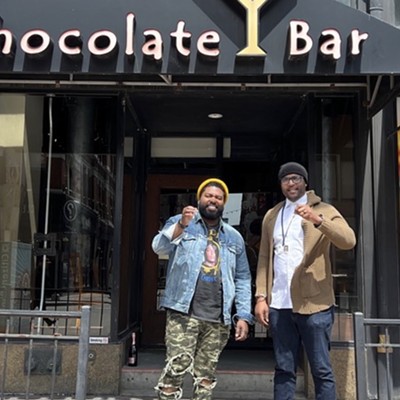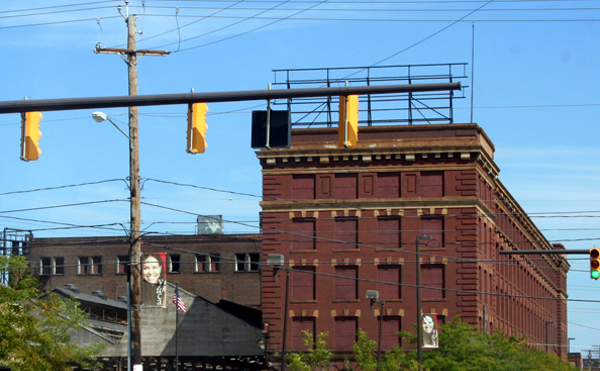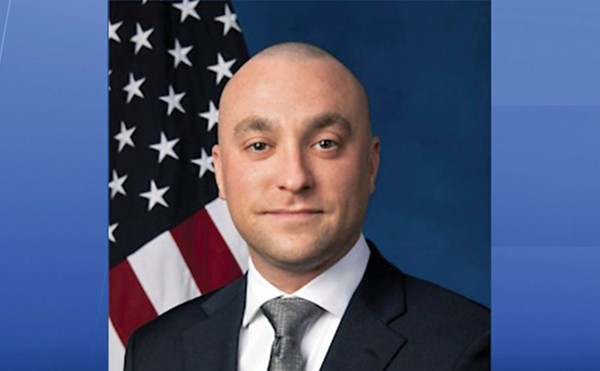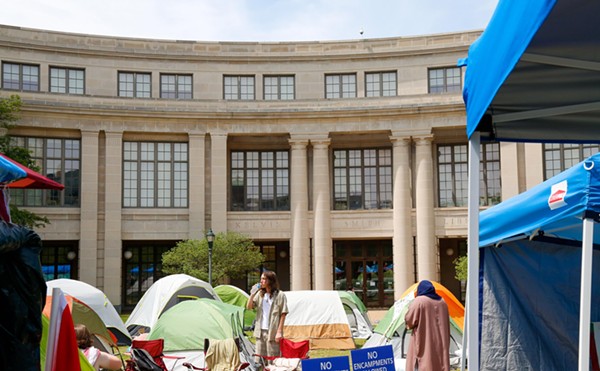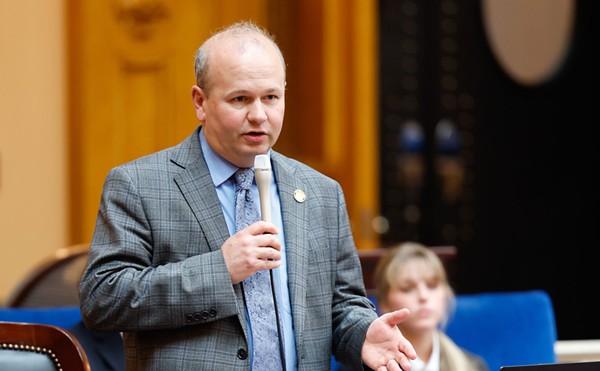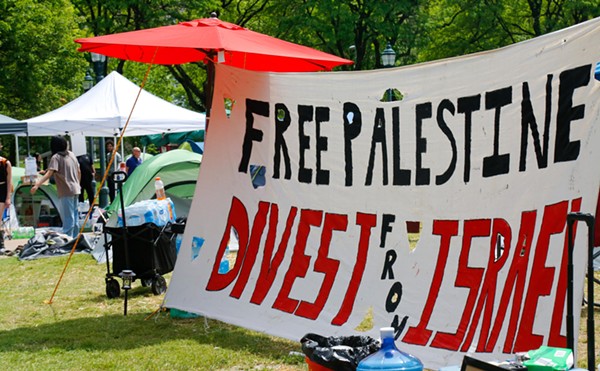If you've hung out on West Sixth Street in recent years, you might have bumped into Gilbert Mendez, the energetic, sociable, suit-wearing, fancy car-driving 37-year-old former owner of the now defunct Club Sin nightclub.
Club Sin fit in with the rest of the entertainment district in some ways and stood out in others. It was filled with promoters and faux glitz and glamour, offered the usual bottle service and VIP fun behind velvet ropes, and came equipped with burly bouncers, DJs and shot girls.
Mendez was no stranger to those parties. He was a businessman, through and through, and he ran what was, by most accounts, a successful nightclub packed by shot-slurping crowds every weekend.
He was also no stranger to federal prisons or the Cleveland police department. That history, which rubbed into his present day operation, is what landed Club Sin in the crosshairs of a drug task force.
A February 2015 Federal indictment charged Mendez with running a coke distribution operation out of Club Sin. The investigation included phone taps, GPS tracking, stakeouts, controlled buys, friends turning on friends — really, the whole shady shebang.
It all began back in the summer of 2011 when two paid informants set up a coke deal in the VIP room of Club Sin and ended with federal charges against seven men accused of having a role in a West Side drug ring. There were at least 15 other targets along the way — some caught state charges, some fell off the Northern Ohio Law Enforcement Task Force's radar, some became informants.
But Mendez was the center of it all for the task force, which was made up of local detectives and FBI agents, and once they tapped his phone and tracked his cars, he flipped to informant before the indictment came down against six of his associates — Alexander Febres, Joseph Velez, Erick Mendez, Paris Valles, Israel Cortes, and nightclub promoter/rapper Ivan Salcedo Torres (known as "Bully Cashtro").
But the story is more complex than just the indictment of seven men. The investigation slithered its way through the Cleveland nightlife scene, doubled back to buys at cell phone stores and auto body shops, and ended with the main target on the run.
Gilbert Mendez has spent the majority of his adult life behind bars -- 120 months in all -- or on probation.
His first federal bust, also nightclub-related, was in 1997. A then 19-year-old Mendez had been transporting cocaine from Cleveland south to clubs in the Cincinnati area, where law enforcement there just happened to be orchestrating a year-long undercover operation.
He was arrested alongside five others when Cincinnati police seized 4.4 pounds of cocaine (worth $400,000 on the street, as reported the Cincinnati Enquirer at the time, which seems a bit high, at today's rate), and $15,000 in cash.
"These are not small-time dealers by any stretch of the imagination," Cincinnati police captain Richard Biehl, now Dayton's police chief, said at the time.
Mendez was convicted of possession with intent to distribute and sentenced to 57 months in prison followed by five years of probation.
Shortly after he was released, back in Cleveland and on parole, DEA records indicate Mendez quickly rejoined the game. In 2004, four informants told a DEA agent and Cleveland police that Mendez had delivered them at least 20 kilograms of cocaine -- 44 pounds -- over the previous year. The evidence against Mendez was slim -- it was just the testimony of informants -- but he admitted to investigators at least some of it and faced at least a decade in prison based on his prior conviction committing the crimes while on probation.
But you can always negotiate.
In 2005, he struck a deal with the Feds, pleading to a lesser charge.
As part of the deal, Mendez agreed to provide the Feds with something more useful -- information against others related to his bust and his testimony against others in future cases. Before his plea deal, he had already met with law enforcement and provided statements.
"Additionally," his plea deal stated, "the defendant has expressed an interest to fully cooperate in this case and any other case indicted as a result of his cooperation."
He was sentenced to 78 months, far less than what he would have gotten without cooperating, at the federal prison in Coleman, Florida, followed by five years probation. Three years in, however, U.S. attorneys filed a motion to knock off some years on his sentence after more of his information proved useful in additional convictions.
Federal judge Donald Nugent agreed, chopping 15 months off his sentence.
In 2009, Mendez left prison and immediately began working at Traffic Night Club, which later became Sin Night Club. (The address is now home to Martini 6, for geographical perspective.)
There, the twice-convicted cocaine dealer partnered up with a fifth district Cleveland cop named Jose Torres (known as "Tito"), among others.
Torres, now 40, had an inauspicious start to his law enforcement career. In 2001, while a cadet in the Cleveland police academy, he got in a fight at 2:30 a.m. outside of a nightclub on Scranton Rd. According to the arrest warrant, "Torres engaged in two physical assaults," punching a guy in the face and kicking him while he was laying on the ground, which "incited several other members of the crowd to join in" and beat the guy up. Three Cleveland police officers who were working secondary employment there saw what happened, and "two of the officers later positively identified Torres as the person inciting the crowd," it says.
He'd be charged with inciting violence, a charge later dropped by the prosecutor, and disorderly conduct, of which he was found not guilty at trial in 2002 -- witnesses' memory, mostly Cleveland cops, became faulty when it was time to testify. He was then commissioned as a Cleveland police officer, with back pay. (The city of Cleveland has not yet responded to a public records request for Torres' secondary employment records. Torres responded to a set of questions via Facebook message from Scene with a thumbs-up icon.)
Mendez started five years of probation when he returned home from prison in the 2009. By October 2011, however, his lawyer, Edward LaRue (the same lawyer who represented Torres after his 2001 arrest), filed a motion to terminate his supervised release. Mendez had had enough of the drug tests and checkups. He had completed his 63-month prison sentence and a 500-hour drug program. He hadn't failed a test since release and had been employed full time at "Strugga, Inc." (actually spelled "Struga, Inc." in legal documents; the company was an umbrella for a variety of clubs and restaurants in Northeast Ohio), the motion stated.
Included in the court filings were three character references -- letters lobbying judge Nugent to release Mendez from probation.
The first was from his fiancé's mother. She called him a "polite and hard-working man with integrity," who "was honest about his past experiences. He continues to work hard at being successful and prosperous and has taken good care of our daughter financially and otherwise. His character has always been forthright and sincere and the plans for his future that he has shared with us are honorable and promising."
The other two references came from the Cleveland police department.
Captain Dan DePiero was a colleague of Torres' in the fifth district. He's also an attorney, and he's also represented Torres in recent civil litigation. (Around 2013, Torres wanted to open a nightclub on Memphis Ave, and he paid the owner of a building $80,000; when the deal didn't go through, the building owner agreed to pay Torres back in installments, with interest. When he missed a payment last summer, DePiero, on behalf of Torres, filed suit.)
DePiero had known Mendez since he was released from his second stint in prison and vouched for him. (DePiero hung up the phone when Scene sought comment for this story.)
His September 12, 2011 letter to the judge read:
Dear Judge Nugent:
I have known Gilbert Mendez for the last two years. During this time, Gilbert has led a law abiding life, established a relationship with his daughter, is a good father, and has held steady employment.
Sincerely,
Dan R. DePiero
Cleveland Police Captain
The third letter came from Cleveland narcotics detective George Redding, who said he first met Mendez a decade prior when he was on post-prison supervised release following his first federal cocaine conviction. (Redding did not return calls seeking comment for this story.)
Honorable Donald Nugent:
This is a character and personal reference letter for Gilbert Mendez; He is on probation to you and would like his probation to be terminated. I have been acquainted with Gil since about 2001 or so. We met when I was a patrol officer while he was waiting to pay his debt to society. Gil has been a positive and law abiding family guy since I've known him and since he's returned. He has been gainfully employed and I have not observed or have any knowledge of things being any different.
Since becoming a detective, I do a lot of undercover work and have observed Gilbert Mendez's actions on several occasions. And I have not seen anything that would indicate anything different than above.
Respectfully
Det/ George Redding #2327
The motion to terminate Mendez's probation was denied by Judge Nugent.
A public records request for secondary employment records for DePiero and Redding has not been answered by the city of Cleveland as of press time.
Two sources tell Scene more than one Cleveland police officer was notified by the FBI via letter that they were picked up on the wire of Mendez's phone. Department of Justice spokesman Mike Tobin declined to comment. Messages seeking comment from the city of Cleveland were not returned.
In August 2011, three Cleveland detectives -- two of which were assigned to the task force -- met with an informant, an "associate" of a man named Alexander Febres.
"Alex" and "Gil [Mendez]," he told the detectives, had an entire cocaine operation running through Sin nightclub. They'd "receive kilogram quantities" of cocaine there, repackaged it, and sold it out of the VIP room. Febres and Mendez would regularly drive to Chicago in different cars to pick up cocaine, the CI said; the duo also had a supplier in Florida.
The informant "stated that Gilbert Mendez owns Club Sin with a Cleveland Police Officer named Juan Torres aka, 'Tito,'" wrote Cleveland police detective James Cudo, a lead investigator in the task force, in an affidavit nearly two and a half years later about the meeting.
It is not clear why Cudo wrote "Juan" instead of "Jose" in the affidavit -- Jose Torres and Cudo are colleagues, it was no secret that Jose Torres was involved in the club, and records and police rosters were available to him to check Jose Torres' affiliation. In that affidavit, written in Dec. 2013, Cudo made a footnote regarding the informant's statement: "It is unclear at this point of the investigation whether Torres is involved with this establishment." Records available to Scene do not indicate whether the task force cleared up that question.
But sources tell Scene that Mendez and Torres were business partners around the start of the investigation in 2011, which was put on hold later that fall for nearly two years. They'd part ways in the coming years, we were told, by the time the task force seriously dove into the investigation again in the second half of 2013.
Shortly after that August 2011 meeting with the informant -- an associate of Alex Febres -- the task force brought in two paid informants with no previous connection to Mendez and Febres.
The pair met with Mendez inside Sin's VIP room and set up a deal. They met back at the club a few weeks later, where Mendez and Febres told them an ounce of cocaine would cost $1,400. A week later, in October, Febres met the two informants at a house around West 30th Street and Monroe -- a block from St. Ignatius in Ohio City -- where he sold them 21.4 grams of cocaine, all recorded on audio and video for the task force.
According to task force records obtained by Scene, that's it for the investigation until midway through 2013.
In the meantime, Mendez violated his post-release probation, according to a January 2013 probation violation hearing in federal court: "The defendant admitted to violating the terms of supervised release for a new law violation and possession of a controlled substance."
Records detailing how that violation came about were not available, but later records detail "Numerous State ID Cards," "Numerous Credit Cards," "Marijuana and Glass Pipe," and a passport that were seized. Mendez was cited by Cleveland Police June 25, 2012, for a car noise violation, but there's no indication the stop included anything more than that.
The federal probation department recommended "the defendant participate in cognitive behavioral therapy." Mendez would not be going back to prison -- perhaps a sign that something deeper was in the works: A sweeping investigation is impossible with your main target locked up and unable to lead you to others.
Which is likely why when Mendez ran into police again on March 1, 2013, and was arrested for disorderly conduct intoxication, a prosecutor promptly dismissed the charge.
By 2013, the task force was back on Mendez's trail, with a new weapon in their investigation: an informant known in court records as "CS5" (Confidential Source 5).
At the task force's direction and surveillance and using their money, CS5 made tens of thousands of dollars worth of cocaine purchases from Mendez between April and December 2013. The task force recorded his phone calls with Mendez, decoding his verbiage when discussing drug deals to provide clues for later conversations when they'd tap his phone. When Mendez needed more cocaine for a deal with CS5, they'd track Mendez to his suppliers and associates.
And this was important, because between when the investigation started in 2011 and when it was picked back up in 2013, the investigation into Mendez and Febres had expanded beyond West Sixth Street to houses, business, and side streets throughout neighborhoods on the West Side of Cleveland. An auto shop owned by one of Mendez's friends had become a hub for the operation. Mendez was tooling around in a number of different cars -- a SAAB, a Mercedes, a Honda Accord, a Trail Blazer.
Other than a single controlled buy by CS5 in April 2013, the action didn't get going until that August, when investigators started documenting Mendez's paranoia -- which turned out to be based in reality -- about getting caught. He was clearly aware of the possibility he was being watched. He took down license plate numbers of cars that he thought looked suspicious. He insisted CS5 get in his car -- a controlled environment, he thought -- when they'd meet for a deal. When he drove to meeting with his associates to check if any car was following, he'd drive randomly on side streets that were out of his way, constantly making quick turns; on the highway, he'd get on and get off again.
On September 12, for the first time, a federal judge authorized using a "pen register" and "trap and trace" on Mendez's phone.
Soon came a full wiretap of his phone, allowing investigators to listen in on his calls in real time. And then the GPS tracking devices that were installed on his ever-changing fleet of cars. Which is how they learned that "Do you wanna eat at Willie's Restaurant?" was really code for meeting at his buddy Israel "Izzy" Cortes' auto shop on West 63rd Street and Storer to discuss and conduct deals. And it led to Joseph Velez, a previously convicted dealer, and Erick Mendez, whose house Gilbert Mendez used for business. And it led to a search warrant for Febres' apartment, where they found 470 grams of coke and a variety of drug-related tools.
But the biggest piece of the investigation had not yet come.
Things dramatically changed, for everybody involved, on the afternoon of Monday, December 18, 2013. Something happened that wasn't supposed to happen quite yet: Gilbert Mendez discovered a GPS tracking device on his Honda Accord.
At 5:29 p.m., the task force received an automated text message that the GPS unit was removed. They immediately went to the auto shop -- his car was parked out front; the GPS tracker that was supposed to be affixed to it was registering elsewhere.
At 6:01 p.m., Mendez's girlfriend called him. He told her to get in his Trail Blazer and come to the shop, quickly. She pulled into the garage 16 minutes later. Mendez got in the Trail Blazer, his girlfriend got in the Accord, and they both headed back to their condo in Parma, where another investigator had set up surveillance.
Mendez quickly left his condo in his Trail Blazer. Investigators followed him, and since the GPS was likely compromised, they pulled him over.
And that was the moment Mendez realized his extreme paranoia was reality. He had been followed all along. One of his main customers had been wearing a wire. His phone was tapped. He was fucked.
Like before, there was only one thing Mendez could do: cooperate. And that's when, in the task force's eyes, he went from the Gilbert Mendez the main target of a drug trafficking organization, to Gilbert Mendez, "Confidential Source 14."
That evening he spilled a lot, corroborating for the task force evidence against his associates, backing up what they had seen and heard through surveillance and with the phone tap.
Yes, he told them, on Dec. 6 he did take the hydraulic press used for reprocessing kilograms of cocaine from Erick Mendez's house to Joseph Velez like they saw. And yes, that's what he referred to as "my daughter's toy" on the phone. Yes, Velez and Paris Valles reprocess cocaine at a house on Finn Ave. Yes, that's Paris Valles in that picture, the guy referred to as "P" on the phone. Yes, he took a dye-cast mold from Alex Febres' house, used in the reprocessing of cocaine, to Velez and Valles at a spot on West 60th Street.
Late that night, investigators drove to the house of Cuyahoga County Common Pleas Judge Michael Astrab and presented him with a search warrant affidavit for that Finn Ave home. It couldn't wait until the morning.
Astrab signed it at 1:44 a.m.
At 2 a.m., they hit the house, where they found 300 grams of cocaine and a kilogram press. From Valles' Jeep Liberty in the driveway, they seized his dashboard GPS unit.
Later in December, and through the following weeks, it was Joseph Velez's turn to flip. He would wear a wire to record a purchase from an East Side supplier who later caught state charges.
The task force still wanted more out of Mendez.
After he was detained and flipped, Mendez would implicate a man named Ivan Salcedo-Torres. That time he sold CS5 a kilogram of cocaine for $27,000? That was supplied by "Bully," he told them on January 21, 2014. He pointed the guy out in a photo lineup.
Mendez and Salcedo-Torres, 31, definitely know each other from the West Sixth Street nightclub scene. Salcedo-Torres, known to his friends as "Bully" or by his stage name "Bully Cashtro" (or Ca$htro), was an over-the-top flashy nightclub promoter and rapper. On his Facebook page -- which investigators used to verify his identity by cross referencing his phone number caught on Mendez's wiretap -- he posted hundreds of fliers promoting nightclub events (most recently advertising "Social Fridays" at Rumor, or Saturday nights at Anatomy with "$5 CIROC $3 BUD LIGHT $200 VIP SECTION W/ BOTTLE OF CHOICE"). There were also pictures of Salcedo-Torres wearing suits and posing in nightclubs. He'd done promotional work for Club Sin. He and Mendez went back.
His phone conversations with Mendez were recorded in a November 2013 wiretap back when Mendez was a target and not an informant. It recorded them setting up meetings and vaguely talking about deals, with the task force's GPS unit affixed to Mendez's car recording where they went.
At the end of Jan. 2014, he called Bully and set up a meeting.
That meeting would go down inside a cell phone store on East 79th Street and Cedar Ave. The task force hooked an audio recording device onto him and set up surveillance in a nearby parking lot. Salcedo-Torres was peaking out the front window when Mendez pulled up at 11:16 a.m. on Jan 30. Inside, Mendez talked about buying five ounce of cocaine from his nightclub colleague. It was "A-1" quality, Bully told him, fresh off a brick with the ridges still intact, for $1,250 per ounce. They left after 20 minutes.
They met the next day on the West Side. Mendez gave Bully $5,200 in cash, and said he'd pay the remaining balance later. Bully handed over the five ounces.
More than a year after Gilbert Mendez wore a wire to help the Feds, he's on the run.
He never showed up for his April 16, 2014 federal parole violation hearing.
There are no shortages of rumors on his whereabouts. Some think he's in Hong Kong. Some think he fled to Florida en route to Puerto Rico, where he has family.
Other say "Food Stamp," as he's known to some pals and associates, could not have possibly been a snitch. That, of course, isn't true.
"Mendez is not in custody," Department of Justice spokesman Mike Tobin told Scene last week. "Law enforcement agents are looking for him."
His former associates probably are too.


